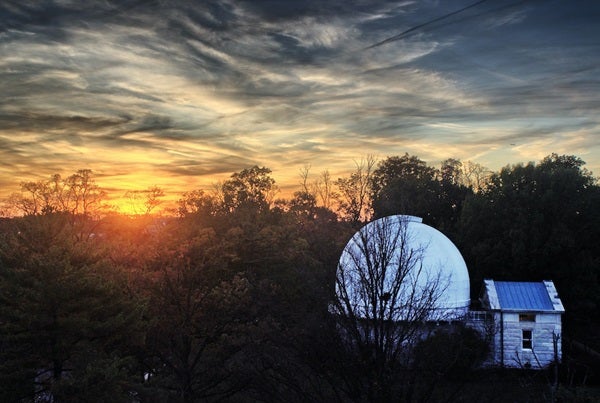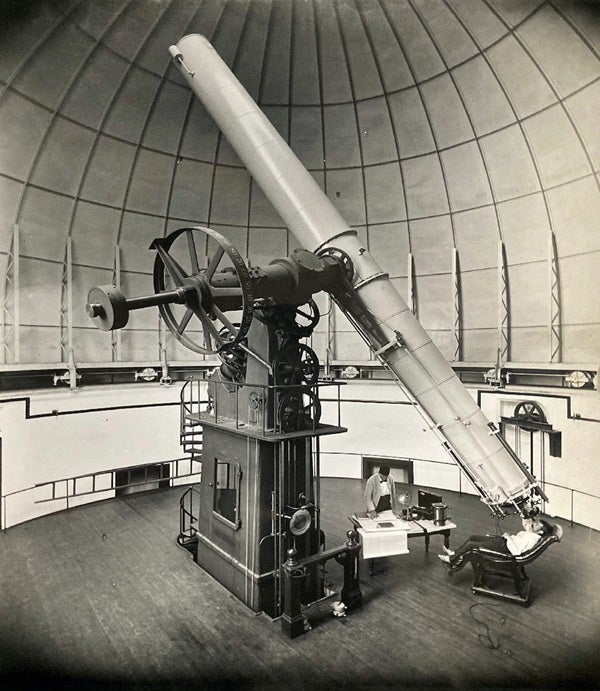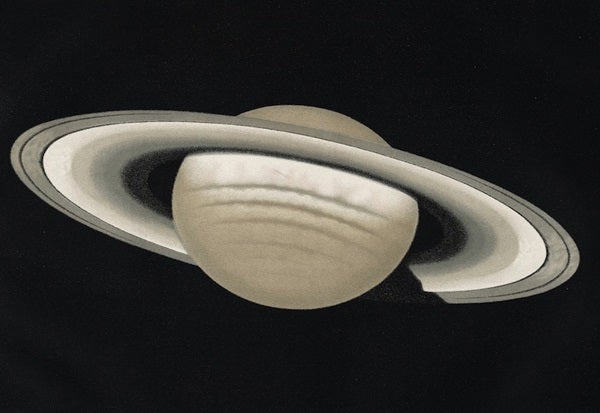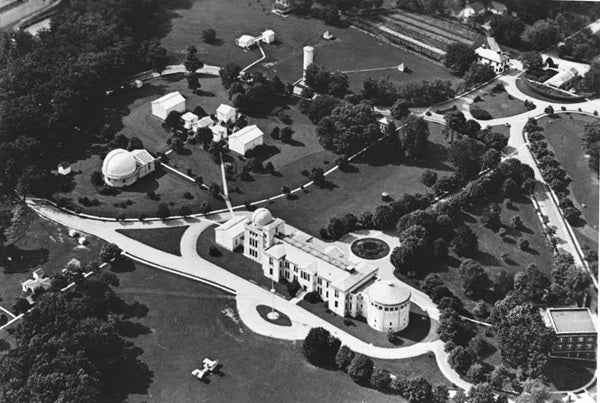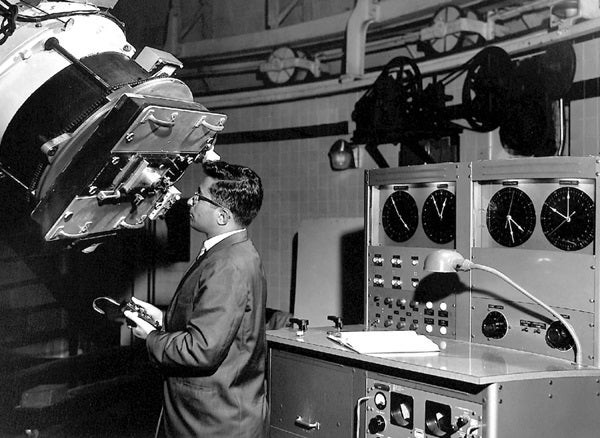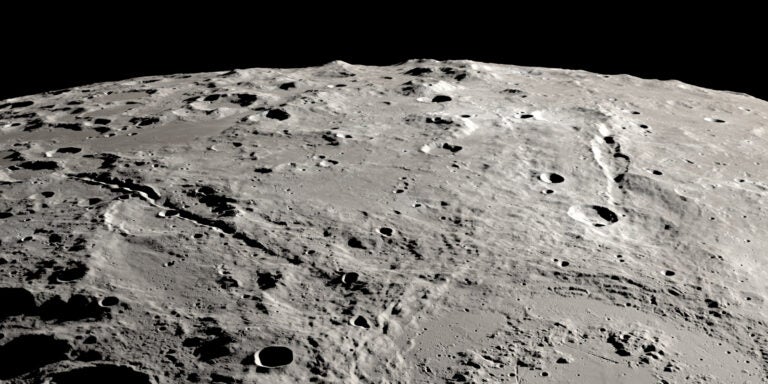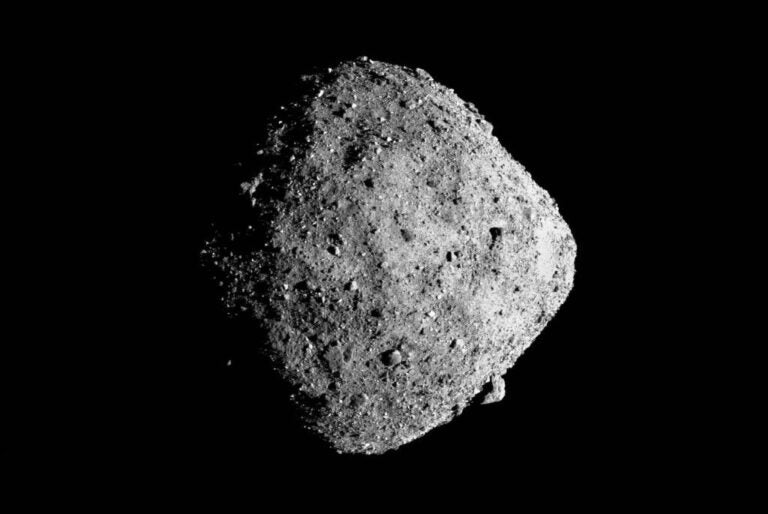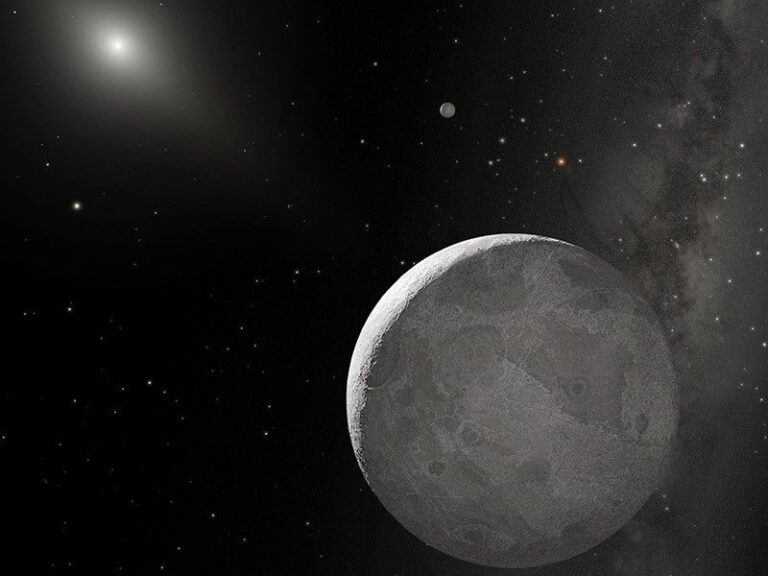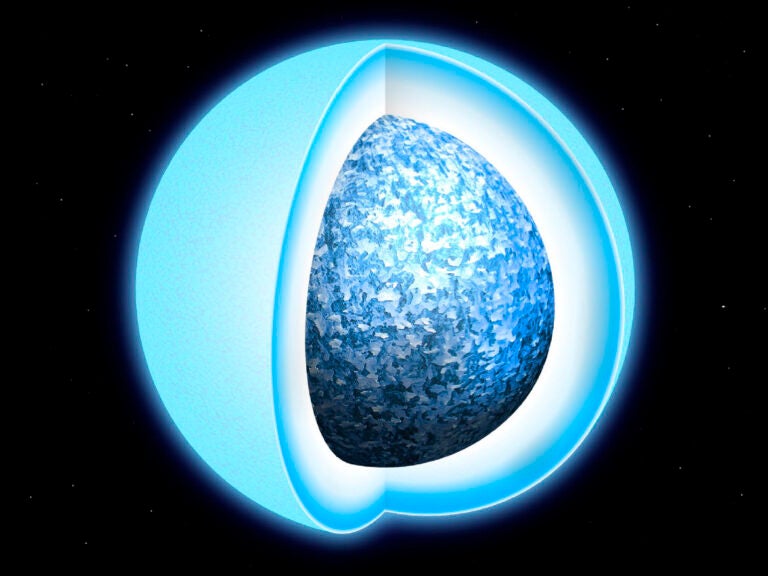It was 1868, and the United States Naval Observatory (USNO) had a problem on its hands. Despite its importance as the nation’s official timekeeper and prestige as an astronomical research institute, its equipment was lagging in one crucial aspect: size. The largest telescope at the USNO was a 9.6-inch refractor — inadequate for tackling many of the most important observations of the era, like the moons of the outer planets.
That year, in a report to the Navy’s bureau chief of navigation, the USNO’s superintendent Benjamin Sands lamented: “The comparatively small size of the instrument prevents it from entering into competition with many telescopes of other observatories in the observation of faint objects.” Even more embarrassing, the 9.6-inch scope was not “at all comparable with many owned by colleges, observatories and private individuals throughout the country.” Sands added: “This will seem the more remarkable since the most successful living constructor of telescopes is an American — Alvan Clark of Cambridge, Massachusetts.”
Five years later, the USNO was rewarded with the most powerful instrument that the renowned Alvan Clark & Sons firm had ever built.
This year, that 26-inch refractor turns 150 years old. When it was completed in 1873, it was the world’s largest telescope, vaulting the USNO back into the ranks of elite observatories. But what is perhaps most remarkable about this telescope is its longevity. Unlike so many other great telescopes of its era, the USNO 26-inch has remained a scientific workhorse well into the age of space exploration and digital imaging, building on its legacy even today.
The craftsman
Alvan Clark was an inventor, portrait painter, and self-taught optician. In the 1850s, he and his two sons had a machine shop in Cambridgeport, Massachusetts. Alvan Clark & Sons took on all sorts of machining jobs, but their true passion was constructing telescopes and grinding and polishing lenses.
Unfortunately, they were not getting much work for astronomy. Their tools were crude, and Boston’s academic elite looked down on Clark’s lack of formal training. But Clark’s exceptional eye and craftsmanship came to light after he struck up correspondence with British astronomer William Rutter Dawes, an expert on double stars. Clark told Dawes of pairs he had been able to split with his telescopes. An impressed Dawes gave him more targets to attempt and commissioned a 7.5-inch refractor from him.
In 1857 in Monthly Notices of the Royal Astronomical Society, Clark and Dawes reported a slew of new double stars — many of which had previously gone undetected by much larger telescopes. Dawes raved about Clark’s discoveries, calling them by turns “truly astonishing,” “almost startling,” and demonstrations of what “may be achieved by a diligent use of instruments of moderate dimensions, provided they are also of extreme perfection.”
It was the recognition the Clarks needed: Soon after, they turned their business wholly over to telescopes and optics, and orders began to pour in — especially after they built the 18.5-inch Dearborn scope and discovered the long-predicted companion to Sirius, the white dwarf known as Sirius B.
By 1868, word had gotten round that Clark wanted to build the largest telescope in the world, but was waiting for a client who could afford the price tag of $40,000 in gold. The USNO’s Benjamin Sands suggested the buyer should be Uncle Sam. Invoking patriotic pride, he wrote, “it seems eminently desirable and proper that the government of the United States should employ at its observatory such an instrument of the highest power.” But his request was denied.
It wasn’t until 1870 that the USNO broke through D.C.’s insider politics. The opportunity came when Cyrus Field, the financier behind the first transatlantic telegraph cable, visited Washington and hosted a dinner with senators Hannibal Hamlin of Maine and Eugene Casserly of California. In conversation, Field’s son was asked what he had done in Washington. He said he had visited the USNO, and he remarked on the small size of their telescope. Incredulous, the senators promised swift redress. Funding for the 26-inch was approved in July 1870 — $55,000 for the telescope, dome, and pier.
By October 1872, Clark had finished grinding and polishing the lens, which consisted of a 70-pound (32 kilogram) crown-glass element and a 110-pound (50 kg) flint-glass element finely separated by 0.029 inches (0.74 millimeters). In October 1873, Clark & Sons delivered and installed the telescope. The tube was placed in a harp-shaped mount based on a design by Simon Newcomb, a senior astronomer at the USNO. The telescope, installed at the observatory’s Foggy Bottom site in Washington, D.C., included two finders, periscopes for reading right ascension and declination, micrometers, and a spectroscope. The wooden dome was plated with galvanized iron; the observing slit was covered with surplus sailcloth.
Newcomb’s first look through the telescope left him profoundly moved. “I was filled with the consciousness that I was looking at the stars through the most powerful telescope that had ever been pointed at the heavens, and wondered what mysteries might be unfolded,” he later wrote. “The night was of the finest, and I remember, sweeping at random, I ran upon what seemed to be a little cluster of stars, so small and faint that it could scarcely have been seen in a smaller instrument.”
Weighing the solar system
The newly minted telescope was quickly put to its first “great work,” as Newcomb called it — observing the moons of the outer planets. This was key to the main scientific justification for the 26-inch: investigating the errors in the position of Jupiter and Saturn. These two beacons of the night sky had long been important objects for celestial navigation, but astronomers had realized that their motions were being perturbed by the gravitational influence of Uranus and Neptune. Thus, the masses of the outer planets were important to Newcomb’s models of the solar system. And the best way to measure the masses of Uranus and Neptune was to observe the motions of their moons.
Regular operations with the 26-inch commenced Nov. 20, 1873, with observations of Neptune’s moon Triton and the four then-known moons of Uranus. Here, the scope could show its power: It was large enough to see moons as faint as magnitude 14, and its very long focal length allowed it to accurately determine their motions. Observations of the satellites of the outer planets featured in the telescope’s first publications, authored by Newcomb and his associate, Edward S. Holden. Remarkably, the 26-inch continued this observing program for over 100 years.
But while Newcomb was keen on improving his models, he was not an industrious observer. In 1875, he turned over operation of the 26-inch to Asaph Hall, who had joined the USNO 13 years earlier. By contrast, Hall was a prodigious observer and published over 1,700 double-star measurements. Considering each published measurement was the average of many repeated measurements, he may have made over 20,000 individual measurements.
The 26-inch also made a splash with the public. At the invitation of the USNO superintendent, the French artist Étienne Léopold Trouvelot looked through the 26-inch in late 1875 and made a series of pastel drawings, including Saturn, the Omega Nebula (M17), and the Orion Nebula (M42). These were exhibited at the U.S. Centennial Exhibition in 1876. Before advances in photography, they were the best available representations of objects in the night sky — the era’s equivalent of images from the Hubble or James Webb space telescopes.
But the most famous discovery in the history of the 26-inch occurred only four years after first light, when Hall turned the 26-inch to look at Mars during a close approach. At the time, no moons had yet been discovered around the Red Planet. Distrusting Holden, whom he saw as something of a spy for Newcomb, Hall waited until he wasn’t around and then swung the telescope to Mars to go moon hunting.
Late on the night of Aug. 11, 1877, Hall saw a faint object which later proved to be Deimos. But conditions prevented follow-up observations for four nights. Finally, on Aug. 16, the skies cleared and he was able to re-observe Deimos, as well as spot a now closer and brighter moon, Phobos, and verify they were moving with the planet and not mere background stars. The news of the discovery appeared in newspapers all over the world.
But within the USNO, it also was the source of more friction and misunderstanding between Hall and Newcomb. In Hall’s initial descriptions, he was modest and cautious about the finds — which led Newcomb to think Hall didn’t realize they were moons of Mars. Hall thought Newcomb was trying to take credit and steal his discovery. But luckily, they were able to resolve their differences later in life.
Fleeing the swamp
Unfortunately, Foggy Bottom wasn’t merely a name, but a condition. Fog frequently rolled in off the Potomac, reducing the output of all telescopes at the USNO. In 1877, 168 nights were too cloudy for observing, and 133 were poor; only 21 nights were recorded as good or very good. Indeed, surrounded by a swamp to the south, coal gas works to the west, and an open sewer to the east, conditions were rarely good for anything except breeding mosquitoes: The superintendents, their families, and staff astronomers all suffered from malaria.
By late 1877, they were looking for a new site, and maintenance of the existing facility languished. When the USNO finally began construction on a new location in the hills above Georgetown in the late 1880s, they took advantage of the opportunity to upgrade the 26-inch. The Warner & Swasey Company reinstalled the Clark doublet in a 14-section tube and made a new, more robust mount, pier, and dome. And a new 15-ton boiler-powered elevating floor eliminated the need to clamber up a ladder to use the telescope; instead, the floor lifted the observer to the eyepiece. The 26-inch resumed operation when the USNO opened its new site in 1893.
About 50 years after the discovery of Mars’ moons, the 26-inch played a key role in another significant discovery about Phobos. In the 1920s, Harry Burton, using the 26-inch, thought he might have detected that Phobos was accelerating in its orbit, indicating it was spiraling inward towards Mars. Bevan Sharpless made similar observations in 1939 and 1941 with the 40-inch reflector, and in 1945, he published his results confirming that Phobos is indeed doomed — getting closer and closer to Mars at the rate of roughly 0.8 inch (2 centimeters) per year.
After Burton’s retirement, the planetary program wound down until 1967 when, in support of NASA’s mission planning, Dan Pascu began observing once more the satellites of Mars and the outer planets using the 26-inch. These observations eventually supported NASA’s Voyager 1 and 2 probes that ventured to the outer solar system and beyond.
Double stars
The other great work of the 26-inch’s illustrious career has been its observations of double stars. In fact, the first orders to Matthew Fontaine Maury, the first superintendent of the USNO, in 1846 specifically mentioned the need to observe double stars. But in the telescope’s early history, this took a back seat to solar system work.
Other than the work of Hall, the 26-inch contributed few double star observations until nearly the 1960s, when Kaj Strand came to the USNO. Strand, who became the observatory’s scientific director in 1963, had been trained by Ejnar Hertzsprung in the use of photography for measuring doubles.
Shortly thereafter, at a meeting of the double- and multiple-star division of the International Astronomical Union in Hamburg, Germany, Lick Observatory announced it wished to divest itself of the responsibility for maintaining the IAU’s double star database, the Index Catalog of Visual Double Stars (IDS). Strand volunteered the USNO for this task and in August 1964, the IDS was transferred to the USNO and renamed the Washington Double Star Catalog (WDS).
Charles Worley, a former member of Lick’s staff, was tasked with maintaining it. After the tailpiece of the 26-inch was modified to accommodate the photographic double-star camera in 1958, the telescope began a new era, with an emphasis on double stars that continues to this day.
Worley and the 26-inch continued to evolve their techniques. In 1981, the photographic program ended. But filar micrometry, in which an observer uses an eyepiece with a reticle to measure the separation of a double star, continued. Worley was particularly skilled at this art, which had been used on the 26-inch since 1873. But in the twilight of his career, he abandoned it for the superior technique of speckle interferometry, which extracts information from the small spots or “speckles” that appear around an image of a star due to interference effects caused by atmospheric turbulence. In a 1987 interview, 10 years before his death, he quipped, “I’m the last generation of visual observers, and I should be the last generation of visual observers. I think it’s time to do this kind of astronomy in different ways.”
Speckle observations of double stars continue on the 26-inch to this day. The USNO’s first speckle camera, with an intensified CCD detector, was installed in 1990; in 2019, it was retired in favor of a newer, more advanced electron-multiplying CCD.
As a result, in terms of total number of measured relative positions, the 26-inch is the most productive telescope for double-star astronomy ever. The WDS is legendary in the field and remains the gold standard for double-star catalogs: As of August 2022, it contained over 155,000 double stars.
After a century and a half, the venerable 26-inch shows no signs of giving out or letting up. As Worley said in 1988: “The truth of the matter is that this is often rather a good climate, as far as the steadiness of the atmosphere goes, so I think the telescope has the potential of continuing to produce good astronomical observations.”
Happy birthday, telescope!
The era of the great refractors
Historically, refracting telescopes were limited in size due to aberrations. The first large telescope to correct for this was the 9.6-inch Great Dorpat Refractor in Tartu, in modern-day Estonia. Constructed in 1824 by Joseph Fraunhofer, it was used by German astronomer Friedrich Georg Wilhelm von Struve. What followed was a technology contest throughout the 19th century to build the largest telescope — the era of what we now call the great refractors. Telescopes built by Alvan Clark & Sons held the top spot five different times, and the USNO’s 26-inch was the largest in the world from 1873 to 1880.

